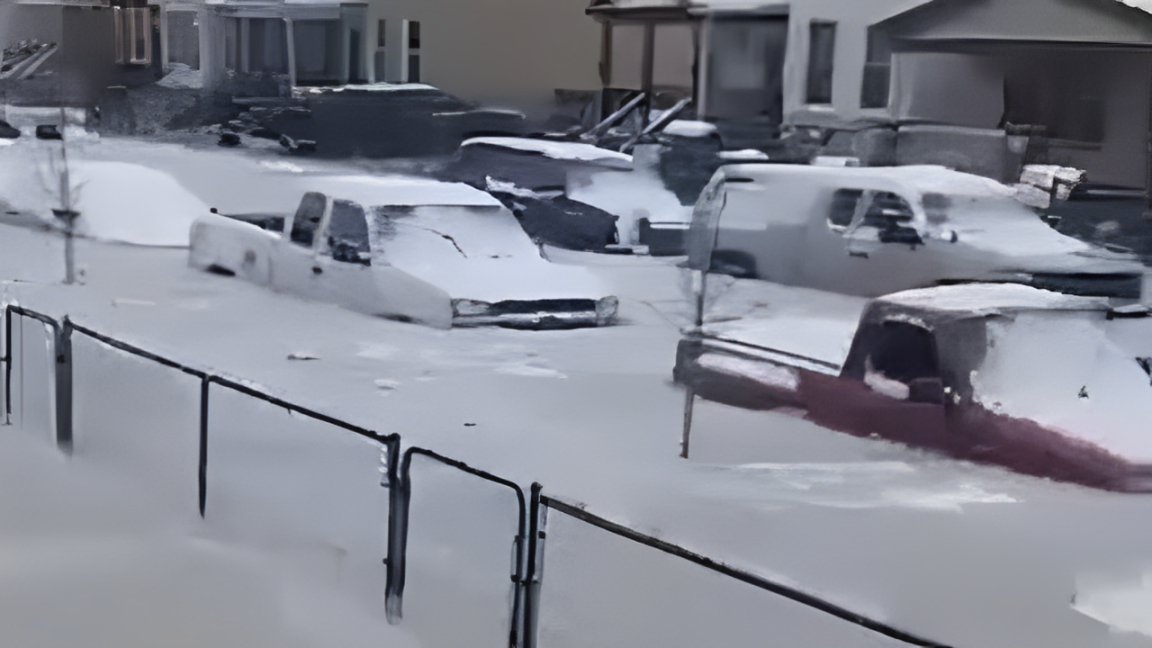In the early hours of Monday, February 17, 2025, residents of a Southwest Detroit neighborhood were jolted awake by an unprecedented crisis.
A massive 54-inch water main, installed in the 1930s, ruptured near the intersection of Beard and Rowan streets, unleashing a torrent of water that rapidly inundated the area.
As temperatures plummeted to -21°C (-5.8°F), the floodwaters quickly turned to ice, encasing streets, vehicles, and homes in a thick, immobilizing layer.
Immediate Impact and Emergency Response
The sudden deluge led to approximately five feet of water accumulating in the streets, compelling emergency services to act swiftly.
Firefighters employed rubber rafts to rescue 63 adults and 31 children trapped in their homes. In some instances, residents were evacuated using the bucket of a front loader construction vehicle.
The extreme cold exacerbated the situation, with temperatures dropping as low as -17°C (1.4°F), complicating rescue and recovery efforts.
Mayor Mike Duggan addressed the crisis, stating, “If you don’t have power, you don’t have heat, don’t have water, you do not have to stay in your home.
We will get you into a good hotel room.” Consequently, nearly 300 residents were relocated to hotels, as many homes were left without electricity and heat due to the flooding.
Infrastructure Challenges and Ongoing Repairs
The ruptured water main, a critical component of Detroit’s aging infrastructure, was responsible for transporting water from pump stations along the Detroit River to various communities served by the Great Lakes Water Authority.
The cause of the break remains under investigation, but the pipe’s age and the severe cold are suspected contributing factors.
Crews have excavated the site of the rupture and have ordered a replacement for the damaged 12-foot section of the pipe.
The Great Lakes Water Authority anticipates that repairs will take at least two weeks.
In the interim, the city has pledged to cover hotel accommodations and meals for displaced residents, as well as to repair uninsured damages to furnaces and water heaters.
Resident Experiences and Community Resilience
The aftermath of the flood has left residents grappling with significant property damage and uncertainty. Claudia Ortiz, whose home was directly affected, recounted the harrowing experience:
“It looked like a white water rafting river. The water was just coming down so fast. Everybody was so scared.” Ortiz, like many others, faces the daunting task of assessing and repairing damage to her home and belongings.
Linda Hoskins, another resident, described the rapid progression of the flooding: “It just happened so fast. At first, we thought it was coming in through the door. People are going … .”
Despite the challenges, Hoskins has chosen to … in her home, relying on space heaters for warmth.
City Support and Resources
The Detroit Water and Sewerage … (DWSD) has mobilized resources to assist affected residents in response to the disaster.
The city has established a hotline at (313) 267-8000 for reporting emergency water and sewer issues, including street flooding and sewer backups.
Additionally, residents can utilize the “Improve Detroit” mobile app to report issues and seek assistance.
The Detroit Health Department advises residents to engage licensed plumbers for water removal and promptly begin cleanup efforts to mitigate further damage.
Detailed guidance on flood preparedness and recovery is available in the city’s flood preparedness guide.
Read More:
- Detroit Lions’ Jameson Williams Cleared in Gun Case; NFL Declines Action!
- South Beach Wine & Food Festival Kicks Off in Miami!
Looking Ahead: Recovery and Prevention
As the community begins the arduous process of recovery, city officials are emphasizing the importance of preparedness and infrastructure assessment to prevent future incidents.
The aging water infrastructure in Detroit presents ongoing challenges, and this event underscores the critical need for investment in modernization and maintenance.
Residents are encouraged to stay informed about emergencies by signing up for Detroit Alerts 365, a system that provides timely notifications via phone, text, or email.
This service ensures that citizens receive real-time updates during emergencies, enhancing community safety and preparedness.
Conclusion
The February 17 water main break in Southwest Detroit has profoundly impacted the community, highlighting vulnerabilities in the city’s infrastructure and the resilience of its residents.
As repair efforts continue and the ice begins to thaw, the focus remains on supporting those affected and implementing measures to prevent similar disasters in the future.
The collaboration between city officials, emergency responders, and the community exemplifies a collective commitment to recovery and resilience in the face of adversity.
Disclaimer- Our team has thoroughly fact-checked this article to ensure its accuracy and maintain its credibility. We are committed to providing honest and reliable content for our readers.

